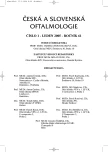-
Medical journals
- Career
The Influence of the Type of Viscoelastic Substances on the Level of Intraocular Pressure after Phacoemulsification
Authors: Š. Skorkovská; J. Michálek *; Z. Mašková; S. Synek
Authors‘ workplace: Klinika nemocí očních a optometrie LF MU, Fakultní nemocnice u sv. Anny, Brno, přednosta doc. MUDr. Svatopluk Synek, CSc. ; Katedra aplikované matematiky a informatiky, Brno, vedoucí doc. Ing. Osvald Vašíček, CSc. *
Published in: Čes. a slov. Oftal., 61, 2005, No. 1, p. 13-19
Overview
The aim of study was to asses the influence of the type of viscoelastic substances on the level of intraocular pressure (IOP) after cataract surgery and intraocular lens (IOL) implantation. In the study group of 100 patients Viscoat was used at 32 operated eyes, Provisc at 14 eyes and Duovisc in 54 eyes during phacoemulsification and IOL implantation. IOP was measured before surgery, one day after surgery and one week after surgery. Mean IOP level 1. day postoperatively was 24,94 mmHg in the Viscoat group of eyes, 24,65 mmHg in the Provisc group and 21,09 mmHg in the Duovisc group. The type of viscoelastic substance used during the surgery significantly influenced the level of IOP in the first postoperative day. The level of IOP was significantly lower in the Duovisc group comparing to Viscoat and Provisc. The level of IOP did not differ significantly between the Viscoat and Provisc group. One week after surgery the level of IOP was not significantly different between all types of viscoelastic device. Duovisc was the most profitable viscoleastic substance in the point of view of the course of phacoemulsification, IOL implantation and postoperative level of IOP.
Key words:
viscoleastic substance, phacoemulsification, IOL implantation, intraocular pressure
Labels
Ophthalmology
Article was published inCzech and Slovak Ophthalmology

2005 Issue 1-
All articles in this issue
- The Rabbit’s IOP after Instillation of Antiglaucomatic COSOPT and Aminoacid L-argininin.HCL Mixture in the Conjunctival Sac
- The Influence of the Type of Viscoelastic Substances on the Level of Intraocular Pressure after Phacoemulsification
- Early Functional Effect of the Pars Plana Vitrectomy in Complications of the Proliferative Diabetic Retinopathy
- The Cases of Penetrating Eye Injuries with Large Intraocular Foreign Body
- Ligneous Conjunctivitis: Complication of Inborn Plasminogen Deficiency (a Case Report)
- Evaluation of Functional Complaints and Changed Quality of Life among Patients after Excimer Refractive Surgery
- Ultrastructure of the Iris Pigmentary Epithelium
- Pigmentary Glaucoma after Implantation of the Iris Claw Intraocular Negative Dioptric Power Lens (a Case Report)
- Czech and Slovak Ophthalmology
- Journal archive
- Current issue
- Online only
- About the journal
Most read in this issue- Pigmentary Glaucoma after Implantation of the Iris Claw Intraocular Negative Dioptric Power Lens (a Case Report)
- The Influence of the Type of Viscoelastic Substances on the Level of Intraocular Pressure after Phacoemulsification
- Ligneous Conjunctivitis: Complication of Inborn Plasminogen Deficiency (a Case Report)
- Early Functional Effect of the Pars Plana Vitrectomy in Complications of the Proliferative Diabetic Retinopathy
Login#ADS_BOTTOM_SCRIPTS#Forgotten passwordEnter the email address that you registered with. We will send you instructions on how to set a new password.
- Career

